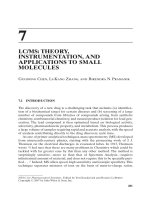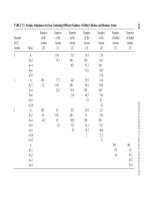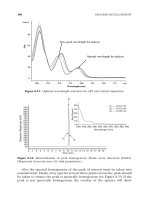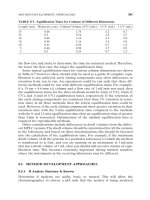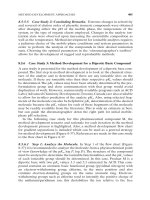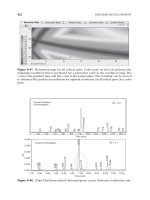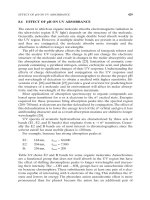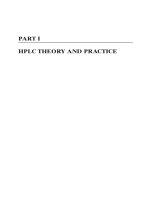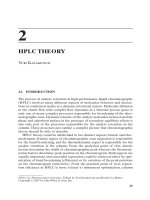Tài liệu HPLC for Pharmaceutical Scientists 2007 (Part 22) docx
Bạn đang xem bản rút gọn của tài liệu. Xem và tải ngay bản đầy đủ của tài liệu tại đây (1.05 MB, 65 trang )
22
CHIRAL SEP
ARATION
Nelu Grinberg, Thomas Burakowski, and Apryll M. Stalcup
22.1 INTRODUCTION
Chirality plays a major role in biological processes, and the enantiomers of a
bioactive molecule often possess different biological effects. For example, all
pharmacological activity may reside in one enantiomer of a molecule, or enan-
tiomers may have identical qualitative and quantitative pharmacological activ-
ity.In some cases, enantiomers may have qualitatively similar pharmacological
activity, but different quantitative potencies. Since drugs that are produced by
chemical synthesis are usually a mixture of enantiomers, there is a need to
quantify the level of the isomeric impurity in the active pharmaceutical ingre-
dient. Accurate assessment of the enantiomeric purity of substances is critical
because isomeric impurities may have unwanted toxicological, pharmacologi-
cal, or other effects. Such impurities may be carried through a synthesis and
preferentially react at one or more steps and yield an undesirable level of
another impurity. The determination of a trace enantiomeric impurity in a
sample of a single enantiomer drug substance in the presence of a range of
other structurally related impurities and a large excess of the major enan-
tiomer remains challenging.
The history of enantiomeric separation starts with the work of Pasteur. In
1848 he discovered that the spontaneous resolution of racemic ammonium
sodium tartrate yielded two enantiomorphic crystals. Individual solutions of
these enantiomorphic crystals led to a levo and dextro rotation of the polar-
ized light. Because the difference of the optical rotation was observed in solu-
tion, Pasteur suggested that like the two sets of crystals, the molecules are
987
HPLC for Pharmaceutical Scientists, Edited by Yuri Kazakevich and Rosario LoBrutto
Copyright © 2007 by John Wiley & Sons, Inc.
mirror images of each other and the phenomenon is due to the molecular
asymmetry [1].
W
hile Pasteur made the historical discovery, subsequent advances in the
resolution of enantiomers by crystallization were based on empirical results.
Several attempts to separate enantiomers using paper chromatography were
met with unsystematic results. In 1952 Dalgliesh postulated that three points
of simultaneous interaction between the enantiomeric analyte and the sta-
tionary phase are required for the separation of enantiomers [2].
Developments in the field of life sciences and in the pharmaceutical indus-
try brought enantiomeric separation to a new level. In the late 1950s/early
1960s, many of the drugs were synthesized and used in a racemic form. An
example with tragic consequences was the use of thalidomide, a sedative and
a sleeping drug used in the early 1960s which produced severe malformations
in newborn babies of women who took it in the early stage of pregnancy. Later
it was demonstrated that only the (S)-enantiomer possesses teratogenic
properties [3].
Introduction of gas chromatography gave a burst to the field of enan-
tiomeric separation. In 1966 a group from the Weizmann Institute of Science
in Israel reported the first successful separation of enantiomers using gas
chromatography.
In a letter addressed to Emanuel Gil-Av after the publication of the first
separation of enantiomers on a chiral separation of enantiomers on a chiral
gas chromatography (GC) stationary phase [4], A. J. P. Martin wrote: “As you
no doubt know, I had not expected such attempts to lead to much success,
believing that the substrate-solvent association would normally be too loose
to distinguish between the enantiomers.” At the time there were just several
reports on the separation of enantiomers using chromatographic methods.
Later developments in HPLC gave an additional boost to the field. Today,
there are over 60 types of rugged, well-characterized columns capable of
separating enantiomers. Unfortunately, there is a great deal of trial and
error in choosing a particular column for a chiral separation. Therefore this
chapter will summarize a rationale for choosing a stationary phase that is
based on the relationship that exists between the analytes and the chiral
stationary phases.
22.1.1 Enantiomers, Diastereomers, Racemates
Chirality is due to the fact that the stereogenic center, also called the chiral
center, has four different substitutions. These molecules are called asymme-
trical and have a C
1
symmetry. When a chiral compound is synthesized in an
achiral environment, the compound is generated as a 50:50 equimolar mixture
of the two enantiomers and is called racemic mixture. This is because, in an
achiral environment, enantiomers are energetically degenerate and interact in
an identical way with the environment. In a similar way, enantiomers can be
differentiated from each other only in a chiral environment provided under
988 CHIRAL SEPARATION
the conditions offered by a chiral stationary/mobile phase [5]. The separation
of enantiomers using chiral stationary/mobile phases involves the formation
of transient diastereomeric complexes between the enantiomeric analytes and
the chiral moiety present in the chromatographic column.
Thus, diastereomers
are chiral molecules containing two or more chiral centers with the same
chemical composition and connectivity. They differ in stereochemistry about
one or more chiral centers. If two stereoisomers are not enantiomers of one
another, they can in principle be separated in an achiral environment—that is,
using a nonchiral stationary phase [5].
22.2 SEPARATION OF ENANTIOMERS THROUGH
THE FORMATION OF DIASTEREOMERS
Formation of diastereomers for chromatographic purposes can be generated
in two ways: transient diastereomers, which occur between the enantiomers
and the chiral stationary phase (CSP) during the chromatographic process.
Such a process is also called direct separation. The second way is to generate
long-lived diastereomers that are formed by chemical reaction between the
enantiomer and a chiral derivatizing reagent prior the chromatography. Such
a process is called indirect separation. Indirect separation of enantiomers is
usually a good technique when everything in direct separation fails. However,
it requires suitable functionality in the enantiomers for reaction with a chiral
derivatizing agent. The effectiveness of this approach may also depend on a
variety of other conditions such as structural rigidity and the spatial relation-
ship between the stereogenic centers of the enantiomers and the chiral center
introduced through derivatization.
When two chiral compounds,racemic A and racemic B, react to form a cova-
lent bond between them without affecting the asymmetric center, the stereo-
chemical course of the reaction can be as follows [6]:
[(±) − A] + [(±) − B] → [+A + B] + [+A − B] + [−A + B] + [−A − B]
where the first and the last products constitute an enantiomeric pair and the
second and the third products constitute a second enantiomeric pair. In con-
trast, the first and the third products and the second and fourth products are
diastereomeric pairs. In a chiral environment, one should be able to separate
all of these four products.However, because diastereomers possess slightly dif-
ferent physicochemical properties, achiral chromatography of this mixture
should lead to two peaks (corresponding to the two diastereomers).
Indirect approaches such as chiral derivatization with chiral derivatiz-
ing reagents (CDR) offers a variety of advantages. For instance, CDRs are
cheaper than chiral columns. Separation of the product diastereomers is gen-
erally more flexible than the corresponding enantiomeric separation because
achiral columns can be used in conjunction with various mobile-phase
SEPARATION OF ENANTIOMERS THROUGH THE FORMATION 989
compositions. Depending on the functional groups on the enantiomers, there
is a variety of CDRs on the market (chiral anhydrides
, acid chlorides, chloro-
formates, isocianates, isothiocianates, etc.) which can be applied, which in turn
can change the selectivity of a chromatographic system.
There are also disadvantages to the chiral derivatization approach includ-
ing extra validation. For instance, the derivatizing reagent has to be optically
pure, or the analysis can generate false-positive results.In addition, special care
needs to be taken that the chiral center of the enantiomers or derivatizing
agent is not racemized during the derivatization reaction. Furthermore,
unequal detector response of the diastereomers must be corrected via stan-
dard procedures [7]. Often, the derivatization requires a long reaction time,
which adds to the analysis time.
22.2.1 Mechanism of Separation
The separation of diastereomeric pair is due to the effect of their nonequiva-
lent shape, size, polarity, and so on, on their relative solvation and sorption
energies [8]. Their interaction with a particular stationary phase is dependent
upon their molecular structure and availability of functional groups able to
interact with the stationary phase. For instance, unsaturated bicyclic alcohols,
which are capable of internal hydrogen bonding, show shorter retention than
epimers or dihydro derivatives, which cannot undergo such types of interac-
tions [9] (Figure 22-1). The compounds of Figure 22-1 were separated by gas
chromatography on a 12-ft ×
1
/
4
-in. column packed with 23% by weight of Ucon
No. 50HB 2000 available from Union Carbide on Celite. As the number of
double bonds increases in the molecules, the possibility of intramolecular
hydrogen bonds between the hydroxyl groups and the double bond increases.
Simultaneously, the potential for hydrogen bond formation between the com-
pounds and the stationary phase decreases. As a consequence, the retention
time of each isomer decreases as the number of double bonds in the mole-
cules increases [10–13].
990 CHIRAL SEPARATION
Figure 22-1. Retention time of bic
yclic alcohols. The numbers under each structure
represent the retention time in minutes. (Reprinted from reference 9, with permission.)
There are few differences between the separation in gas chromatography
[14–16] and the separation in liquid chromatography (LC),
because it is
assumed that the differential solvation of the diastereomeric compounds
during the LC separation does not play a very important role [17]. Helmchen
et al. [18] explained the separation of diastereomeric amides using LC with a
silica gel stationary phase under normal-phase conditions. In order to explain
their separation, the authors made some assumptions:
1. Secondary amides adopt essentially the same conformation in polar solu-
tions and in the adsorbed state (on silica gel).
2. In the adsorbed state, a parallel alignment of the planar amide group
and the surface of silica gel is preferred.
3. Apolar groups (i.e., alkyl, aryl) outside the amide plane cause a distur-
bance of this preferred arrangement in proportion to their steric bulk in
a direction perpendicular to the amide plane. Such groups are classified
as large and small by indices L and S, respectively.
4. That member of a diastereomeric pair in which both faces of the amide
plane are more shielded than the least shielded face in the other member
is eluted first.
5. There is an attractive interaction between small polar groups and the
silica gel, particularly if they are hydrogen bond donors not internally
bonded to the amide group. Formally, such groups are assigned to the S
(small) class.
The actual magnitude of the interaction of a given substituent with the
adsorbent depends on the adsorbent, other substituents present, and the type
and rigidity of the backbone of the diastereomeric analytes. Although no
serious attempts at quantification have been made, repulsive interactions
toward silica and alumina can be ranked roughly as H < methyl < phenyl =
ethyl < tert-butyl < trifluoromethyl <α-naphthyl < 9-anthryl = pentafluoroethyl
< heptafluoroethyl. Size and hydrophobicity are both relevant; incorporation
of polar functionality (hydroxyl, carbalkoxy, cyano) leads to attractive rather
than repulsive interactions with silica.
22.2.2 General Concepts for Derivatization of Functional Groups
As noted previously (Section 22.2), derivatization with a chiral derivatizing
reagent (CDR) requires the presence of suitable functionality (e.g., —OH,
Ar—OH, —SH,—COOH, —CO—, —NH
2
, —NRH) within the chiral analyte
to serve as a reactive site. Before addressing specific issues with regard to CDR
and analyte classes, it may be helpful to review general considerations for
achiral derivatization in chromatographic assays.
Desirable achiral derivatization reaction properties include fast, unidirec-
tional reactions with no or minimal side reactions.In addition, both the reagent
SEPARATION OF ENANTIOMERS THROUGH THE FORMATION 991
and the product should be stable. Most derivatization methods use an excess
of reagent which can present as an interfering chromatographic peak.
Of
course, incorporating a derivatization step in an assay requires additional
materials, time, and effort as well as additional method validation.
In the case of chiral derivatization, there are some unique considerations
in addition to the ones noted above for achiral derivatization. Extra valida-
tion is required to establish the optical purity of the derivatizing agent. In addi-
tion, nonracemization of either the analyte or the derivatizing reagent during
the derivatization must be confirmed. Excess reagent must be used to elimi-
nate any potential chiral discrimination in the derivatization reaction. The
presence of more than one type of reactive group (e.g., amine and alcohol)
must be considered if the selected reagent has different reaction potentials for
each moiety. In some cases, chiral derivatization may be coupled with achiral
derivatization. If more than one reactive functional group is present in the
analyte, usually the derivative in which the two stereogenic centers are in
closest proximity yields the most favorable diastereomeric pair for separation
by achiral chromatography. Also, derivatives that incorporate the most struc-
tural rigidity (e.g., amides versus esters) tend to be the most amenable to sep-
arations by achiral chromatography.
22.3 MOLECULAR INTERACTIONS
Generally speaking, there are three properties involved in an intermolecular
interaction: the probability of the interaction occurring, the strength of the
interaction, and the type of interaction. These properties will be discussed in
the following sections.
22.3.1 The Probability of Molecular Interactions
Achieving enantiomeric discrimination requires understanding the interac-
tions between the selector and the selectand. In his Ph.D. thesis [19], Feibush
postulated that attaining an enantiomeric separation on a chromatographic
chiral system required that certain conditions should exist:
A necessary condition for having a difference in the standard free energy of the
two enantiomers in solution is that the solvent is chiral. The fact that the solvent is
chiral is in itself not sufficient to sustain such difference. A certain solute–solvent
correlation should exist to cause the difference in the behavior of the enantiomers.
There should be strong (solute–solvent) interactions, such as p-complexation,
coordinative bonds, [and] hydrogen bonds, to form associates between the asym-
metric solvent/solute molecules. Such association can be regarded as short-living
diastereomers. When the bonds that form these associates are in immediate prox-
imity of their asymmetric carbons, a difference in the behavior of the enantiomers
in the active phase is possible.We search for active phases and enantiomeric solutes
that can form associates through (preferably) more than one hydrogen bond, and
992
CHIRAL SEPARATION
where these bonds are formed in the immediate proximity of the asymmetric
carbons
. In an associate formed through a single H-bond, free rotation of the
bonded molecules still exists, on the other hand, more bonds prevent this possi-
bility to a large extent, and a solute–solvent associate with a preferred conforma-
tion is formed. In addition, having more H-bonds between the asymmetric solute
and solvent increases the interaction between these neighboring molecules and
increases the population of (the selective) associates where asymmetric carbon
are in close proximity. With the increase of the relative population of these
particular associates from all the possible associates, an increase in the gap of
the free solvation energy of the enantiomers is expected, which enables their GC
separation.
This model can also be extended to enantiomeric separation using liquid
chromatography.
Yet enantioerecognition is still a matter of debate [20–22]. More recently,
Sundaresan and Abrol [23] proposed a novel stereocenter recognition (SR)
model for describing the stereoselectivity of biological and other macromole-
cules toward substrates that have multiple stereocenters, based on the topol-
ogy of substrate stereocenters. The SR model provides the minimum number
of substrate locations interacting with receptor sites that need to be consid-
ered for understanding stereoselectivity characteristics. According to this
model, the substrate locations and receptor sites can have binding, nonbind-
ing, or repulsive interactions that may occur in a many-to-one or one-to-many
fashion. The interactions between the two chiral entities must involve a
minimum number of locations in the correct geometry.The model predicts that
stereoselectivity toward a substrate with N stereocenters in a linear structure
involves N + 2 substrate locations distributed over all stereocenters in the sub-
strate, such that at least three locations per stereocenter effectively interact
with one or more receptor sites.
In building models of possible enantioselective associates, conformational
searching during docking of the selectands (enantiomeric solutes) with the
selector (chiral solvent or ligand) is necessary. Usually it is not known which
conformation of a ligand interacts more favorably with a particular receptor,
and the flexibility of the ligand plays a major role in such computational
approaches [24]. Associations where each of the pairing partners is not in its
preferred conformation play only a minor role in the overall interaction
between the selectand and the selector, and their contribution to the enan-
tioselectivity is minimal.
In Figure 22-2, the diastereomeric associates between the selectand/selec-
tor are formed through one, two, or three substituents of the asymmetric
carbon. The chirality of the selector or the selectand can arise from an asym-
metric carbon, the molecular asymmetry, or the helicity of a polymer.Also, the
bonds between substituents of the selectand and the selector can involve a
single bond, but could also involve multiple bonds or surfaces. Such bonds rep-
resent the leading interactions between selectand and selector. Only when the
leading interactions take place and the asymmetry of the two bodies are
MOLECULAR INTERACTIONS 993
brought in close proximity do the secondary interactions (e.g., van der Waals,
steric hindrance
, dipole–dipole) become effectively involved.
The secondary interactions can affect the conformation and the formation
energy of the diastereomeric associates. If the interaction between the
selectand and the selector takes place through one leading interaction (Figure
22-2A), then the enantioselectivity of the system is governed by the position
of unbounded substituents B, C, and D of the selectand relative to the sub-
stituents F, G, and H of the selector. One particular enantiomer will interact
more strongly with a particular selector if the contour and polarity of the two
molecules are better complements of each other. When the interaction
between the selectand and the selector occurs through two leading interac-
tions (Figure 22-2B), the enantioselectivity of the system is determined by the
effective size of the groups that do not participate in interactions. If, for
example, G of the selector is an alkyl and H a hydrogen substituent, and C of
the selectand is an alkyl group and D a hydrogen, then one enantiomer has
994 CHIRAL SEPARATION
Figure 22-2. Schematic representation of selectand/selector associations. Dashed lines
represent the leading interactions between the two chiral entities. (Reprinted from ref-
erence 25, with permission.)
the larger G and C groups in syn arrangement and the other in anti arrange-
ment.
In a variety of cases involving interactions through hydrogen bonding
or ligand metal complexes, the enantiomer whose larger nonbonded groups
are positioned syn to the corresponding larger group of the selector will elute
last from a chromatographic column, as compared to the opposite isomer that
forms the anti arrangement [25].
The solvation energy of one enantiomer in the active chiral phase can be
described as the contribution of all possible forms of solvent/solute associates.
These associates are in equilibrium with fast interconversion rates. Each form
contributes to the total free energy according to its particular formation
energy and its particular molar fraction [25, 26].These complexes between the
selector and selectand should also be as mutually exclusive as possible, to
prevent a given interaction from occurring at multiple sites in the diastere-
omeric complexes [5].
22.3.2 The Types of Molecular Interactions
Chiral separations generally rely on the formation of transient diastereomeric
complexes with differing stabilities. Complexes are defined as two or more
compounds bound to one another in a definite structural relationship by forces
such as hydrogen bonding, ion pairing, metal-ion-to-ligand attraction, π-acid/
π-base interactions, van der Waals attractions, and entropic component desol-
vation. In the following sections, the most important types of molecular
interactions in chiral separations are discussed.
22.3.3 Chiral Separation Through Hydrogen Bonding
Hydrogen bonding is a donor–acceptor interaction specifically involving
hydrogen atoms [27]. When a covalently bonded hydrogen atom forms a
second bond to another atom, the second bond is referred to as a hydrogen
bond.
A hydrogen bond is formed by interaction between the partners R—X—
H and :Y—R′ according to
R—X—H + :Y—R′↔R—X—H···Y—R′
where R—X—H is the proton donor and :Y—R′ makes an electron pair avail-
able for the bridging bond. Hydrogen bonding can be regarded as a prelimi-
nary step in a Brønsted acid–base reaction, which would lead to a dipolar
reaction product R—X
−
···H—Y
+
—R′.
According to their bonding energy, hydrogen bonds can be subdivided into
three categories: strong, moderate, and weak hydrogen bonds. Strong hydro-
gen bonds are formed by groups in which there is a deficiency of electron
density in the donor group, (i.e., —O
+
—H, >N
+
—H) or an excess of electron
MOLECULAR INTERACTIONS 995
density in the donor group (i.e., F
−
,O
−
—H,
O
−
—C, O
−
—P, N
−
<). They are
referred to as forced strong H-bonds [27].
Moderate hydrogen bonds are generally formed by neutral donor and
acceptor groups, such as —O—H, ¨N—H, or —N(H)—H and O¨,O¨C, or
N¨, in which the donor X is electronegative relative to hydrogen and the Y
atom (the acceptor) has a lone pair of unshared electrons. These are the most
common hydrogen bonds and are essential contributors to the structure and
function of biopolymers.
Weak hydrogen bonds are formed when the hydrogen atom is covalently
bonded to a slightly more electrically neutral atom relative to hydrogen (e.g.,
C—H, Si—H) or when the acceptor group has no lone pair but has π elec-
trons, (e.g., C¨C or an aromatic ring). Although F is a very electronegative
atom, F—C or F—S groups are only weak acceptors. These interactions have
energies and geometries similar to those of van de Waals complexes, and they
are distinguished from them by evidence of a directional involvement of the
X—H bond.
The H-bond is generally assumed to be linear with θ between 175–180°.
The geometrical requirement can, in certain cases, lead to arrangements in
which a covalently bonded H-atom is located close to more than one poten-
tial acceptor atom,leading to a bifurcated hydrogen bond [28]. Such complexes
have lower stability than those with a single hydrogen bond. An example of a
bifurcated hydrogen bond between two drug enantiomers and amylose car-
bamate stationary phase is presented in Figure 22-3.The right-hand side enan-
tiomer undergoes a bifurcated hydrogen bond with the amylose phase,
forming a complex less stable than that from the left-hand side. As a conse-
quence, the enantiomer forming the bifurcated hydrogen bond eluted earlier
from the chromatographic column [29].
996 CHIRAL SEPARATION
Figure 22-3. Interaction of two drug enantiomers with amylose carbamate stationary
phase
. (Reprinted from reference 29, with permission.)
The strength of hydrogen bonds depends on the solvent conditions in which
the complex occurs
. For instance, in the presence of an ionic medium (which
generates an electric field), H-bonds of the solvate become polarized and, con-
sequently, their symmetry can change from a symmetrical to an asymmetrical
H-bond.The change in symmetry leads to weakening of the H-bonds between
the solvate molecules. Furthermore, when the pK
a
value of a dissolved mole-
cule is larger than that of the protonated solvent, the addition of a strong acid
leads the H
+
ions to become attached preferentially to the dissolved molecule
[(BH···B)
+
]. When the pK
a
of the dissolved molecules is smaller than that of
the solvent, the addition of strong bases should favor H-bonds between the
dissolved molecules [(BH···B)
−
] [30].
The amide groups are one of the most important functional groups involved
in designing chiral phases that involve hydrogen bonding. For this reason, a
discussion of the amide structure is critical to understanding the interactions
involved between the selectand and the selector. Furthermore, the amide
group constitutes the backbone of linear peptide chains. The dimensions of a
typical peptide group is given in Figure 22-4. The presence of an asymmetric
center at the C
α
carbon atom, along with the presence of only an L amino acid
residue, results in an inherent asymmetry of the polypeptide chain [31].
Two configurations of the planar peptide bond are possible; the C
α
can be
in either trans or cis configuration, forms that are in equilibrium:
MOLECULAR INTERACTIONS 997
Figure 22-4. T
he geometry of the peptide backbone, with the trans peptide bond,
showing all the atoms between two C
α
atoms of adjacent residues. (Reprinted from
reference 31, with permission.)
The trans form is energetically favored,
due to less repulsion between non-
bonded atoms [31]. For an amide group to hydrogen bond with another mol-
ecule able to undergo such interaction, the H···N distance should be ≤2.3Å
and the N···O distance should be ≤3.2Å. An H-bond between N—H of an
amino acid residue in the sequence m and C¨O of a residue of the sequence
number n is designated as m → n [32].
In the following section, we will present several chiral phases employed
either in GC or in normal-phase HPLC for which the hydrogen-bonding inter-
actions discussed above governs the interactions between the selectand and
the selector. It should be noted that the interactions occurring in GC are
similar to those occurring in normal-phase HPLC.
The first successful chiral phases used under GC conditions were N-
trifluoro-acetyl (TFA)-l-α-amino acid esters. These phases separated race-
mates of the more volatile members of the same compounds [33]. Replacing
the N-TFA moiety of the selector with trichloroacetyl reduced the enantiose-
lectivity by half, while substituting with isobutyryl caused a total loss of the
chiral separation.
The use of N-TFA ester derivatives of dipeptides as chiral phases signifi-
cantly improved the enantioselectivity [34]. The chiral recognition was
observed for a wider class of compounds, and substitution of TFA with acyl
groups did not affect the selectivity.
The diamide stationary phase contained two hydrogen-bonding sites, a C5
and a C7 site, where hydrogen bonding selector/selectand associations could
take place [25]:
The structure of the diamide phase, derived from IR measurements of crys-
talline N-acetyl-l-leucylmethylamide (Figure 22-5) appeared to be similar to
an anti-parallel β-sheet of poly-l-alanine. X-ray diffraction of the d,l-leucyl
derivative showed the C5:C5 association, while the C7 site involved three mol-
ecules in the antiparallel arrangement. Figure 22-6 shows a C5:C5 associate
of the l-diamide selector with l- and d-α-amino acid derivatives [35].The back
of the selector is flanked by a neighboring molecule through a C7:C7 associ-
ate as part of hydrogen bond network of the chiral stationary phase. The N-
TFA-l-α-amino acid ester had the C5 site but was missing the C7 site; as a
consequence, it formed a less organized hydrogen bond network [35].
A different association of the diamide-α-amino acid derivative is based on
a C5:C7 parallel β-sheet arrangement, and it is shown in Figure 22-7. In this
998 CHIRAL SEPARATION
MOLECULAR INTERACTIONS 999
Figure 22-5. (A)
The structure of N-acetyl-l-leucylmethyl amide derived from IR
spectra. (B) The structure of N-acetyl-d,l-leucylmethylamide derived from X-ray dif-
fraction (R = isobutyl). (Reprinted from reference 35, with permission.)
Figure 22-6. T
he hydrogen bond association of the l-diamide phase in its antiparallel
β-sheet conformation with (A) N-TFA-l-α-amino acid alkyl ester and (B) N-TFA-d-
α-amino acid alkyl ester. (Reprinted from reference 35, with permission.)
arrangement, the alkyl substituents of the asymmetric carbons of the diamide
phase and the α-amino acid solute are in close proximity (syn in the L
:L asso-
ciate), while the L:D association on opposite sides of the molecules is anti
[36]. N-TFA-γ-amino acid esters have only a C7 hydrogen-bonding site and
with a diamide phase can give C5:C7 and/or C7:C7 association with the C5
or C7 site of the phase.
The alkyl substituent of the asymmetric carbon of the d-enantiomer is syn
to the R group of the l-diamide in either the C5:C7 or C7:C7 association. In
general, all l-α-amino acid derivatives with an apolar R group, as well as d-γ-
amino acid derivatives, interact more strongly with the l-diamide than their
antipode; as a consequence, they elute last from the column.The main feature
of these complexes is that the alkyl groups at the asymmetric carbons are in
the syn position, yielding a more retained enantiomer than those in anti
(Figure 22-7).
This principle also governs the separation on the commercially available
Chirasil-Val
®
[37, 38]. In Chirasil-Val
®
, the chiral entity was incorporated in a
polysiloxane backbone for higher thermal stability. Some of the compounds
separated on Chirasil-Val
®
contained only groups, such as N-TFA-proline
esters, that are able to accept hydrogen bonding. To undergo such an interac-
tion, the diamide phase has to have a conformation where both NH groups
point toward the selectand in a conformation similar to the α-helix structure
of proteins [36].
1000 CHIRAL SEPARATION
Figure 22-7. Hydrogen bond association of N-acetyl-l-valyl-tertbutylamide phase in
its parallel β-sheet conformation with the N-TFA-α-amino acid isopropyl ester.
(Reprinted from reference 36, with permission.)
The introduction of the diamide derivatives for enantiomeric separation
was a step forward in designing selectors able to undergo hydrogen bonding
interactions with a wide variety of selectands
. The selector developed by
Dobashi and Hara involved (R,R)-N,N′-diisopropyltartaramide (DIPTA). In
the initial experiments, the selector was used as an additive in a nonaqueous
mobile phase [39]. Enantiomers of α- and β-hydroxy carboxylic acid and
α-amino acids were resolved with this chiral phase. Although addition of
the selector to the mobile-phase complicates the interactions between the
selectand and the selectors, through the introduction of secondary chemical
equilibria, two conclusions could be drawn: (1) An increase in bulkiness of the
N-alkyl-β-hydroxycarboxamides enhanced the separation. The bulkiness of
the N- and O-alkyl groups of N-acyl-α-amino acid esters and amides had a
similar effect. (2) An increase in bulkiness of the N-alkyl groups of N-alkyl-
α-hydroxycarboxamides reduced the separation factors, and a similar effect
was encountered for N-alkyl groups of N-dialkyl-β-hydroxycarboxamides. To
improve the separation, aliphatic β-hydroxycarboxylic acids were derivatized
to α-naphthylamides. Variation in the separation factor due to increased bulk-
iness of the alkyl substituents is likely related to preferential conformations
of the derivatives. Specifically, the increased bulkiness of substituents causes
the threo derivatives to adopt a gauche conformation (I) with regard to the
two hydroxy groups, whereas the erythro derivatives adopt an anti conforma-
tion [39]:
The retention of the enantiomers in the column arises mainly from the equi-
librium between the chiral selector:selectand.A large excess of chiral additive
causes the equilibrium to shift to the association side.An increase in the polar-
ity of the medium decreases the strength of the hydrogen bonding between
the selectand and the selector and shifts the equilibrium towards the dissoci-
ation side. Subsequently, the same selector was bound to a silica support and
packed into an HPLC column; it was also incorporated into a polysiloxane
backbone and used as a chiral phase in gas chromatography in a similar
manner previously used for Chirasil-Val
®
[40, 41].
A variation of these types of chiral stationary phases was reported by
Anderson et al. [42], who synthesized a series of network polymeric station-
ary phase based on para-substituted N,N′-dialkyl-l-tartaramide dibenzoates.
MOLECULAR INTERACTIONS 1001
These chiral phases also operate through hydrogen bonding between the
analyte enantiomers and the chiral stationary phase
, in a manner similar to the
ones developed by Dobashi and Hara [39].
Another type of chiral phase based on hydrogen-bonding interactions is the
polyacrylamide-type phases. Developed by Blaschke, the phase is comprised
of a polyacrylamide that incorporates phenylalanine ethyl ester. The phase
has a helical structure, and the interactions are based on hydrogen bonding
between the polar groups of the enantiomer and the CO—NH groups of the
polymer [43, 44].
In an effort to resolve a broad class of racemic heterocyclic drugs such as
barbiturates, succinimides, glutaramides and hydantoins, a chiral stationary
phase was developed that could undergo simultaneous triple hydrogen bonds
with these analytes (Figure 22-8) [45]. The active part of the selector is a
2,6-pyridinediyl-bis(alkanamide), which is a complementary base that forms
highly selective base pairs with these types of drugs. Chromatographic reten-
tion times (under normal-phase conditions) were directly linked to the for-
mation of the base pairs. Compounds that can form the base pairs have
substantial retention times, while closely related compounds that contain
groups interfering with the base-pairing site elute in the void volume.
22.3.4 Chiral Separation Through Inclusion Compounds
Inclusion complexing partners are classified as hosts and guests [46].There are
two types of hosts that were successfully employed in the chromatographic
separation of enantiomers: hosts that have a hydrophobic interior and hosts
with a hydrophilic interior.The hydrophilic interior means that the cavity con-
tains heteroatoms such as oxygen, where lone-pair electrons are able to par-
ticipate in bonding to electron acceptors such as an organic cation (e.g., chiral
crown ethers). In contrast, a host with a hydrophobic interior cavity is able to
include hydrocarbon-rich parts of a molecule [47]. This type of host is found
in the cyclodextrins.
22.3.4.1 Cyclodextrins. Cyclodextrins (CDs) were first isolated in 1891 as a
degradation product of starch, and they were later characterized by Saenger
as cyclic oligosaccharides [48]. If the amylose fraction of starch is degraded by
glucosyltransferases, one or several turns of the amylose helix are hydrolyzed
off and their ends are joined together, producing cyclic oligosaccharides called
cyclodextrins. Because these enzymes are not specific, the hydrolysis produces
a number of CDs with a variable number of sugar units. The most abundant
are α-, β-, and γ-cyclodextrin (α-CD, β-CD and γ-CD, respectively) with six,
seven, and eight glucose rings, respectively, also called cyclohexa-, cyclohepta-,
and cyclooctaamylose (or CA6, CA7, CA8). Beyond these homologues, three
more CDs have been characterized with 10, 14 (ε-CD and ι-CD, respectively),
and 26 glucose rings. Larger homologues were synthetically produced [49].The
chemical structure of CA7 is depicted in Figure 22-9.
1002 CHIRAL SEPARATION
Structures such as CA6, CA7,and CA8 have a doughnut shape and are able
to host small molecules inside their cavity
. Similar to amylose, the glucose units
in the CAs are linked by α(1 → 4) bonds that adopt a
4
C
1
chair conformation.
They may be considered as rigid building blocks giving fairly limited confor-
mational freedom of the macrocycle in rotation of the C6–O6 groups and
limited rotational movements about the glucosidic link C1(n)-O4(n − 1)-C4
MOLECULAR INTERACTIONS 1003
Figure 22-8. Structure of the complex between the stationary phase, a derivative
of N,N′-2,6-pyridinediylbis[(S)-2-phenylbutanamide] boned to silicagel and (S)-
hexobarbital (top). X-ray structure of the 1:1 complex of N,N′-2,6-pyridinediyl-
bis(butanamide) and bemegride. (Reprinted from reference 45, with permission.)
(n − 1).
All glucose groups are aligned in cis configuration with the secondary
O2 and O3 hydroxyls on one side, connected by O2(n)···O3(n − 1) hydrogen
bonds, and the primary O6 hydroxyls on the other side. The smaller CA6 to
CA8 have the overall shape of a hollow, truncated cone with the wide side
occupied by O2 and O3 and the narrow side occupied by O6 [49].
There are a number of requirements for chiral discrimination using CDs.
In cases where inclusion complexation is required, there must be a relatively
tight fit between the complexed moiety and the CD. In addition, the chiral
center or one substituent of the chiral center must be close to and interact
with the 2- and 3-hydroxyl groups located at the rim of the CD cavity [50]. For
example, the inclusion complexes of guests d- and l-propranolol with β-
CD are placed identically within the CD cavity, and the structures are over-
laid identically to the point of chiral carbon (Figure 22-10). The hydroxyl
group attached to the chiral carbon is in the same position for the d- and l-
enantiomer placed for optimal hydrogen bonding to a 3-hydroxyl group of the
CD. Differences between the two complexes can be observed with respect to
their secondary amine group. In the d-propranolol complex, the nitrogen is
placed between the 2- and 3-hydroxyl groups at distances of 3.3 and 2.8Å,
respectively, which is well in the range of the length of a hydrogen bond. The
amine in the l-propranolol complex is positioned less favorably for hydrogen
bonding. The distances to the closest 2- and 3-hydroxyl group of CD are 3.8
and 4.5Å, respectively. These findings suggest that the complex of d-propra-
nolol with β-CD has higher stability than the complex with the l-propranolol.
Thus, under chromatographic conditions with β-CD as chiral bonded phase,
the d-enantiomer will be retained longer in the column.
Empirical rules for successful chiral recognition candidates using cyclodex-
trins selectors have evolved based on extensive chromatographic data. For
1004 CHIRAL SEPARATION
Figure 22-9. Chemical structure of CA7 (β-CD) where the numbering of glucose unit
(1–7) is performed counterclockwise (left).Atom numbering scheme for a glucose unit
(right). (Reprinted from reference 49, with permission.)
instance, the presence in the guest molecule of at least one aromatic ring
enhances chiral recognition with β-CD
, although two appear to be more ben-
eficial, particularly if the chiral center is positioned between the two rings or
between a single aromatic ring and a carbonyl [50].The enhanced chiral recog-
nition was attributed to increased molecular rigidity [51]. Similar conclusions
were reported by Armstrong et al. [52] for the separation of metallocene enan-
tiomers where the chiral centers, upon inclusion, were located near or at the
rim of β-CD. The metal ion was found to have no direct contact with the
cyclodextrin; the interaction is called “second-sphere coordination” [53]. More
linear metallocene enantiomers have to be complexed in a bent or skewed
position to obtain optimum orientation. If the chiral center is buried between
two bulky groups,however, the enantiomeric separation vanishes. Potential for
hydrogen bonding between the enantiomers and the secondary hydroxyls of
the CD should exist [54], although enantiodiscrimination, using mobile phases
containing β-CD as additives, has been reported for terpene enantiomers,
which lack hydrogen-bonding moieties [55–57]. The stoichiometry of com-
plexation between the guest and the host CD in free solution can vary (e.g.,
from 1:1 to 1:2 guest:CD) [50, 56, 58]. For example, inclusion complexes
between β-CD and (S)-(+)- and (R)-(−)-fenopren (Figure 22-11) [59] occur in
the crystal structure through a 2:1 stoichiometry in which the (S)-(+) isomer
is sandwiched in a dimer between two molecules of β-CD arranged head-to-
tail, while the (R)-(−) isomer is sandwiched between two molecules of β-CD
arranged in a head-to-head arrangement. The carboxylic group of the (S)-(+)
isomer forms hydrogen bonding with the secondary hydroxyl groups of β-CD
while (R)-(−) does not [59].
The chromatographic separation of enantiomers using CDs is usually
performed using aqueous–organic mobile phases. The apparent pH of these
MOLECULAR INTERACTIONS 1005
Figure 22-10. Computer projections of inclusion complexes of (A) d-propranolol
and (B) l-propranolol in β-CD. Dashed lines represent potential hydrogen bonds
(Reprinted from reference 50, with permission.)
mobile phases must be carefully controlled in order to handle the charge of
the enantiomeric analytes
. For example, separation of nicotine and nicotine
analogues [54] could not be achieved at pH values lower than 5. This was a
consequence of the protonation of nitrogens in the analyte molecules. At
higher pH values, complete separation could be achieved, indicating that
enantiomeric separation required the nitrogens to be partially deprotonated.
Simultaneously, the hydrogen bonding between the β-CD and the analytes
occurs through O—H to N.
The concentration of organic modifier in a hydroorganic mobile phase also
influences retention. For instance, retention of analytes decreased as the
amount of acetonitrile in the hydroorganic mobile phase increased up to a
point, after which the retention started increasing again. Such behavior may
indicate a change in retention interactions with the increase amount of ace-
tonitrile in the mobile phase. No reversal of elution order was observed, indi-
cating that no change in the enantioselective interactions occurred [54].
Polar organic mobile phases, such as mixtures of methanol and acetonitrile
with small amounts of acetic acid and triethylamine, can also be effective for
the separation of enantiomers mediated by the CDs. Under these conditions,
the interior of the CD cavity is occupied by acetonitrile. The overwhelming
concentration of acetonitrile renders its displacement by the enantiomeric
analytes basically impossible. Acetonitrile is a polar aprotic solvent, with
limited capacity for hydrogen bond formation. As a consequence, under these
conditions, analytes are thought to undergo hydrogen bonding with the
secondary hydroxyl groups located at the rim of the CDs. The addition
of methanol and traces of acetic acid and triethylamine allows solute reten-
tion to be modulated through solvent mediation of the hydrogen bond
strength [60].
1006 CHIRAL SEPARATION
Figure 22-11. Chemical structure of (S)-(+)-(left) and (R)-(−)-fenopren (right).
(Adapted from reference 59.)
Derivatized CDs have also been used successfully in HPLC.Armstrong and
co-workers [61,
62] synthesized several derivatized β-CDs and used them as
chiral stationary phases under normal-phase conditions. Under these condi-
tions, inclusion is unlikely. A number of substituted derivatives were prepared
including acetic anhydride, (R)- and (S)-1-(1-naphthyl)ethyl isocyanate, 2,6-
dimethylphenyl isocyanate and p-toluoyl chloride. The presence of aromatic
substitution provides possibilities for π–π interaction with the aromatic sub-
stituents of the enantiomeric analytes [61, 62]. For example, in (R)-(−)-, or (S)-
(+)-1-(1-naphthyl)ethyl carbamate of β-CD, the naphthyl ethyl moiety has
some π donor character. Incorporation of 3,5-dinitrophenyl substituents on
chiral analytes promotes formation of a π–π complex. At the same time, the
carbamate functionality that links the aromatic group to the β-CD produces
sites that are able to undergo hydrogen bonding as well as dipole stacking with
the enantiomeric analytes. An illustration of a possible association complex
formed between a chiral analyte and the derivatized CD is shown in Figure
22-12 [61]. For clarity, only one naphthylethyl carbamate substituent is shown
in Figure 22-12. The degree of substitution actually achieved is between three
and eight substituents. Other orientations include positioning the phenyl ring
of the solute over the cyclodextrin cavity, which results in a variety of inter-
actions which can contribute to enantiomeric recognition.
22.3.4.2 Crown Ethers. Crown ethers can be described as heteroatomic
macrocycles with repeating units of (—X—C
2
H
4
—) where the heteroatom
X is usually oxygen, but may also be sulfur or nitrogen. They can also
MOLECULAR INTERACTIONS 1007
Figure 22-12. Schematic illustrating likely π–π and dipole stacking interactions
between the 3,5-dinitrophenyl carbamate derivative or sec-phenyl alcohol and the
naphthyl carbamoylated β-CD stationary phase
. (R = H or naphthylethyl carbamate).
(Reprinted from reference 61, with permission.)
incorporate aromatic moieties which enhance their lipophilicity. These types
of compounds were first synthesized by Charles J
. Pedersen, who named this
class of compounds “crown ethers” [63]. The simple crown ether compound,
18-crown-6, was also found to complex with alkyl ammonium salts [64]. The
structure of the complex of 18-crown-6 with ammonium and alkyl ammonium
salts is presented in Figure 22-13.
Each oxygen atom possesses two unshared electron pairs. All six oxygens
of the cyclic ether are turned inward to provide dipole-to-ion attractive inter-
actions between host and guest. The main source of interaction is pole–dipole
attraction between
+
NH···O and
+
N···O. Three hydrogen bonds between the
ammonium hydrogens and the crown ether oxygens can be formed. The eth-
ylene units of the crown ether are turned outward and form a lipophilic barrier
around the hydrogens of the hydrophilic ammonium ion. While the host mol-
ecule is roughly planar, and the nitrogen of the guest is situated slightly out of
the plane at the apex of a shallow tripod, it may be argued that the associa-
tion between the crown ether and the ammonium is not really an inclusion
complex. The alkyl group attached to the nitrogen extends along the axis per-
pendicular to the plane of the cyclic ether (Figure 22-13). The ammonium ion
can complex at either of the two faces of the cyclic polyether. The counterion,
X
−
, in a nonpolar environment, ion pairs with N
+
from the face opposite that
occupied by the ammonium ion [65]. Such complexes constituted the start for
Cram’s complexes with chiral ammonium salts. To achieve enantiomeric sep-
aration, Cram introduced additional functional groups such as naphthalene
rings into the crown ether structure, which provided additional interac-
tions capable of discriminating between the enantiomers. The host that
contained two chiral elements (Figure 22-14) provided the highest chiral
selectivity [66].
In Figure 22-15, the four planes of the four naphthalene rings are perpen-
dicular to the plane of the oxygen atoms, and form walls along the sides of the
macrocycle. The space above, below, and along the side the macrocycle is
divided by the four walls into four equivalent cavities, two above and two
below the macrocycle [65]. The chiral cavities possess a pocket on one side
(left side, Figure 22-15) and a barrier on the other (right side, Figure 22-15).
1008 CHIRAL SEPARATION
Figure 22-13. The structure of the complex between 18-crown-6 and alkyl ammonium
salts. (The R group in the left structure is not included). (Reprinted from reference 65,
with permission.)
Thus, when crown ether from Figure 22-14 complexes an optically active
ammonium salt whose asymmetric center is adjacent to the primary ammo-
nium groups
, the same complex is formed whether the ammonium group com-
plexes from the top or from the bottom of the host. In the complex, the large
(L), medium (M), and small (S) groups attached to the chiral center must dis-
tribute themselves into the two equivalent cavities. In Figure 22-15, L is dis-
tributed in one cavity and M and S are distributed in the second. In the more
sterically stable diastereomeric complex, molecular models predicted that M
would reside in the pocket and S would reside against the barrier. This model
is referred to as the three-point binding model and was confirmed by para-
magnetic resonance (pmr) spectra [67].
Another example of such complexes is the interactions between the chiral
18-crown-6 and phenyl glycine, which is presented in Figure 22-26 [68]. Later,
the chiral 18-crown-6 was immobilized on silica gel and polystyrene resins and
used as a stationary phase in liquid chromatography for the separation of
amino ester salts. Despite the fact that baseline separation was obtained
MOLECULAR INTERACTIONS 1009
Figure 22-14. The structure of chiral crown ether. (Reprinted from reference 66, with
permission.)
Figure 22-15. Interaction of a chiral 18-crown-6 with a chiral alkyl ammonium salt.
(Reprinted from reference 67, with permission.)
Figure 22-16. Structure of (l)-phenyl glycine (left) and the complex with chiral crown
ether (right). (Reprinted from reference 68, with permission.)
between the enantiomeric pairs, the chiral recognition on the bonded phase
was smaller than in solution [69,
70].
Shimbo et al. used a chiral 18-crown-6 (Figure 22-17) dynamically coated
on a reversed-phase stationary phase [71, 72]. This crown ether is commer-
cially available under the trade name Crownpak CR.
This crown ether is able to resolve a large number of enantiomeric amines,
amino alcohols, and amino acids using reversed phase conditions. It was found
that additives such as perchlorate play an important role in chiral separation.
This observation is compatible with the theory of chaotropicity.An anion with
high chaotropicity is characterized by high polarizability. Such anions are able
to break the structure of water, making it more lipophilic. In the hydration
shell of such anions, the water’s protons are directed in toward the anion [73].
In a series of anions such as ClO
4
−
,CF
3
COO
−
,NO
3
−
, and H
2
PO
4
−
the retention
factor of amino alcohols such as cis and trans amino indanol (at a constant pH
of 2) increases in the following order: ClO
4
−
> CF
3
COO
−
> NO
3
−
> H
2
PO
4
−
.The
selectivity factor, however, was not influenced by the nature of the chaotropic
agent [74].
For more hydrophobic analytes, the retention can be modulated by the
addition of organic modifiers such as methanol in the mobile phase. However,
there is not a linear relationship between the amount of the organic modifier
in the mobile phase and the retention factor of the enantiomeric analytes, indi-
cating multiple types of retention interactions [75].
A different type of crown ether used to separate enantiomers is the one
derived from 18-crown-6 tetracarboxylic acid, covalently immobilized on silica
gel via reaction between 18-crown-6 tetracarboxylic acid and amino propyl
silica gel [76]. The structure of 18-crown-6 tetra carboxylic is presented in
Figure 22-18 [77]. The enantioselectivity on this chiral phase is improved by
the addition of triethylamine into the mobile phase and operating at high
methanol concentrations; however, enhanced selectivity may come at the
expense of greatly increased retention times [78].
1010 CHIRAL SEPARATION
Figure 22-17. Structure of Crownpak CR (−). (Reprinted from reference 74, with
permission.)
22.3.5 Charge Transfer
Charge transfer complexes are an electron donor/electron acceptor associa-
tion for which an intermolecular electronic charge transfer is observed [79–82].
Aromatic interactions have been suggested to consist of van der
Waals,
hydrophobic, and electrostatic forces [80]. The electrostatic component has
been suggested to arise from interactions of the quadrupole moments of the
aromatic rings. The edge–face geometry can be considered as a CH–π inter-
action found in benzene in the solid and liquid state and is commonly observed
between aromatic residues in proteins [80]. Aromatic rings can also act as
hydrogen bond acceptors. Energy calculations show that there is a significant
interaction between a hydrogen bond donor (such as >NH group of an amine
or amide) and the center of a benzene ring, which acts as a hydrogen bond
acceptor. This aromatic hydrogen bond arises from small partial charges cen-
tered on the ring carbon and the hydrogen atom.
The formation of a donor–acceptor complex is described as an equilibrium
process characterized by equilibrium constant. The presence of a solvent
affects the complexation constant describing the equilibrium between the indi-
vidual components of the complex. This is due to a competition of the solvent
molecules toward each component of the complex. The solvent does not have
to be a charge-transfer competitor. Competitive interactions such as hydrogen
bonds can also affect the equilibrium. When the equilibrium constant of the
complexation is quite low, the influence of the solvent is very significant, due
to its overwhelming concentration compared to the concentration of the
complex. For example, dioxane or ether are known to be effective n-donors;
chloroform and methylene chloride have proved to participate in hydrogen
bonds with π-donor molecules; and carbon tetrachloride behaves as an elec-
tron acceptor [83].
22.3.5.1 Chiral Separation Through Charge Transfer. The first chiral sepa-
ration to employ solely π–π charge transfer interaction was reported by
Newman and co-workers [84, 85].The authors used R-(−)-2-(2,4,5,7-tetranitro-
9-fluorenylidene-iminoxy)-propionic acid (TAPA) to resolve racemic mixtures
of 1-naphthyl-sec-butyl ether, as well as hexahelicenes, by crystallization.
MOLECULAR INTERACTIONS 1011
Figure 22-18. Structure of 18-crown-6-tetracarboxylic. (Reprinted from reference 77,
with permission.)
